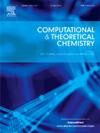Exploring the impact of cyano substitutions in non-fullerene acceptors for enhanced organic solar cell performance: A DFT and TD-DFT investigation
IF 3
3区 化学
Q3 CHEMISTRY, PHYSICAL
引用次数: 0
Abstract
In this study, we designed four new non-fullerene acceptors (ANF1-ANF4) for organic photovoltaic cells derived from a well-known reference compound, Y15. The terminal acceptor of Y15 was modified by removing the chlorine atoms and adding a cyano group at four different positions. To explore the impact of the cynao group substitutions, we investigated the optoelectronic properties of the derived molecules using density functional theory (DFT) and time density functional theory (TD-DFT). We assessed several characteristics of the created compounds, including charge mobilities, molecular planarity parameters, molecular electrostatic potential, frontier molecular orbitals, transition density matrix, interfragment charge transfer (IFCT), and non-covalent interactions (NCI). Compared to the primary molecule Y15, we discovered that all tailored molecules have more planar geometries, a smaller energy gap ranging from 1.55 to 1.60 eV, and better optical properties with a maximum of absorption ranging from 759 nm to 796 nm in the chloroform phase. Moreover, we found that, except ANF4, all the other proposed molecules exhibit higher conductivity due to their lower reorganizational energy values compared to the reference molecule Y15. In particular, the investigation results showed that, given its promising optoelectronic and photovoltaic properties, ANF1 would be a great candidate for usage in the creation of high-performance organic solar cells.

求助全文
约1分钟内获得全文
求助全文
来源期刊

Computational and Theoretical Chemistry
CHEMISTRY, PHYSICAL-
CiteScore
4.20
自引率
10.70%
发文量
331
审稿时长
31 days
期刊介绍:
Computational and Theoretical Chemistry publishes high quality, original reports of significance in computational and theoretical chemistry including those that deal with problems of structure, properties, energetics, weak interactions, reaction mechanisms, catalysis, and reaction rates involving atoms, molecules, clusters, surfaces, and bulk matter.
 求助内容:
求助内容: 应助结果提醒方式:
应助结果提醒方式:


